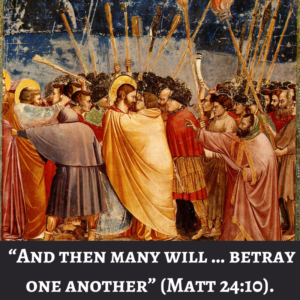
The Scriptures teach a simple prophetic framework that encourages us to fulfill the Great Commission: to make disciples of all nations in this age. We’re making incremental progress toward the goal of discovering that framework. Our starting point is the Olivet Discourse, where a simple, understandable conversation occurs. Jesus says that no stone in the temple would remain intact (Matt 24:1–2). In response, the disciples ask when this event would occur and the signs that would precede it.
The Lord answers the sign question first (Matt 24:4–31). I have divided his signs into three groups: (1) preliminary signs (Matt 24:4–14), (2) a later sign (Matt 24:15–26), and (3) immediate signs that pertain to the temple’s fall (Matt 24:27–31).
I call the first set of signs preliminary because Jesus said they would not mean the temple was about to fall, ending the Mosaic age. He said, “You will hear of wars and rumors of wars. See that you are not troubled; for all these things must come to pass, but the end is not yet” (Matt 24:6).
Jesus makes an obvious progression as he gives these preliminary signs, first listing four general signs. I discussed these signs here and here. Now Jesus turns from general signs that might characterize any period to those that would affect the disciples and their work before the temple’s fall. Jesus reminds the disciples that their transition-period ministry would be “a witness to all the nations” (Matt 24:14). The three signs he gives relate to that mission: (1) persecution, (2) widespread apostasy, and (3) an accomplishment that must precede the end of the Mosaic age.
I discussed the first of these in my last post (here). What about the second?
Widespread Apostasy
Jesus’ second ministry-related sign was widespread apostasy:
And then many will be offended, will betray one another, and will hate one another. Then many false prophets will rise up and deceive many. And because lawlessness will abound, the love of many will grow cold. But he who endures to the end shall be saved. (Matt 24:10–13)
The previous signs—religious deceivers, civil unrest, physical disturbances, and persecution—would contribute to this falling away. Apostasy would be part of the “beginning of the birth pains” (Matt 24:8) but would not show that the temple’s fall was at hand.
The New Testament confirms this apostasy existed in the disciples’ generation. Peter, for example, mentions it in his letters, referring to Jewish Christians as “the pilgrims of the Dispersion in Pontus, Galatia, Cappadocia, Asia, and Bithynia” (1 Pet 1:1). He tells them that “the end of all things is at hand” and “the time has come for judgment to begin at the house of God” (1 Pet 4:7, 17). The temple—the Old Testament house of God (e.g., 2 Chr 29:16)—would soon fall under God’s judgment, signifying the end of the Mosaic age. Peter doubtless remembered Jesus’ warning of apostasy before “the end” came when he wrote:
But there were also false prophets among the people, even as there will be false teachers among you, who will secretly bring in destructive heresies, even denying the Lord who bought them, and bring on themselves swift destruction. And many will follow their destructive ways, because of whom the way of truth will be blasphemed. (2 Pet 2:1–2)
God had “bought” Israel from Egyptian bondage (e.g., Deut 32:6; Exod 15:16; Ps 74:2; 78:54; Isa 43:3–4), but false teachers had deceived many of them. Peter said a similar deception of those God had thus purchased would occur in his generation, fulfilling Jesus’ sign.
The letter to the Hebrews, written between AD 64 and 681 contains several warnings against this apostasy. It places them in a context almost identical to Jesus’ Olivet Discourse: during the “last days” of the Mosaic age (Heb 1:2); when the inferior things of the Mosaic age were about to be removed (Heb 12:27); when the disciples were “receiving a kingdom” (Heb 12:28); when Jesus would come in “a little while” (Heb 10:37); and when God’s judgment was “about to consume the adversaries” (Heb 10:27 HCSB). Hebrews then emphasizes that earthly Jerusalem was not a “continuing city” (Heb 13:14). In this context, the Hebrew Christians must not draw back—apostatize—to perdition as many were doing (Heb 10:39). The Hebrews letter sees Jesus’ apostasy sign in the Olivet Discourse as a present danger.
Paul experienced the ravages of this widespread apostasy. In his second letter to Timothy, he said, “This you know, that all those in Asia have turned away from me, among whom are Phygellus and Hermogenes” (2 Tim 1:15). He mentioned two false prophets, “Hymenaeus and Philetus … who have strayed concerning the truth, saying that the resurrection is already past; and they overthrow the faith of some” (2 Tim 2:17–18). Again, Paul wrote, “Demas has forsaken me, having loved this present world, and has departed for Thessalonica” (2 Tim 4:10). Paul said the Holy Spirit had confirmed the warning Jesus had given in the Olivet Discourse: “The Spirit expressly says that in latter times some will depart from the faith, giving heed to deceiving spirits and doctrines of demons” (1 Tim 4:1).
Conclusion
The apostasy sign Jesus gave in the Olivet Discourse was for the last days of the Mosaic age; it was not a warning about apostasy at the end of history. A paralyzing fear that this is an age of apostasy should not keep us from obeying the Great Commission—the nations will hear and believe our gospel preaching and remain faithful to God in His timing.
Footnotes
- William L. Lane, Hebrews 1–8, Word Biblical Commentary, eds. David Allen Hubbard and Glenn W. Barker, Reissue ed. (Dallas: Word, 1998), lxvi.
